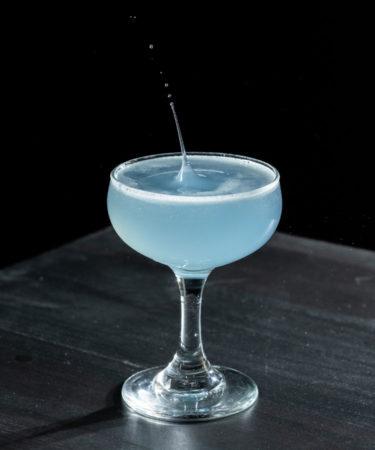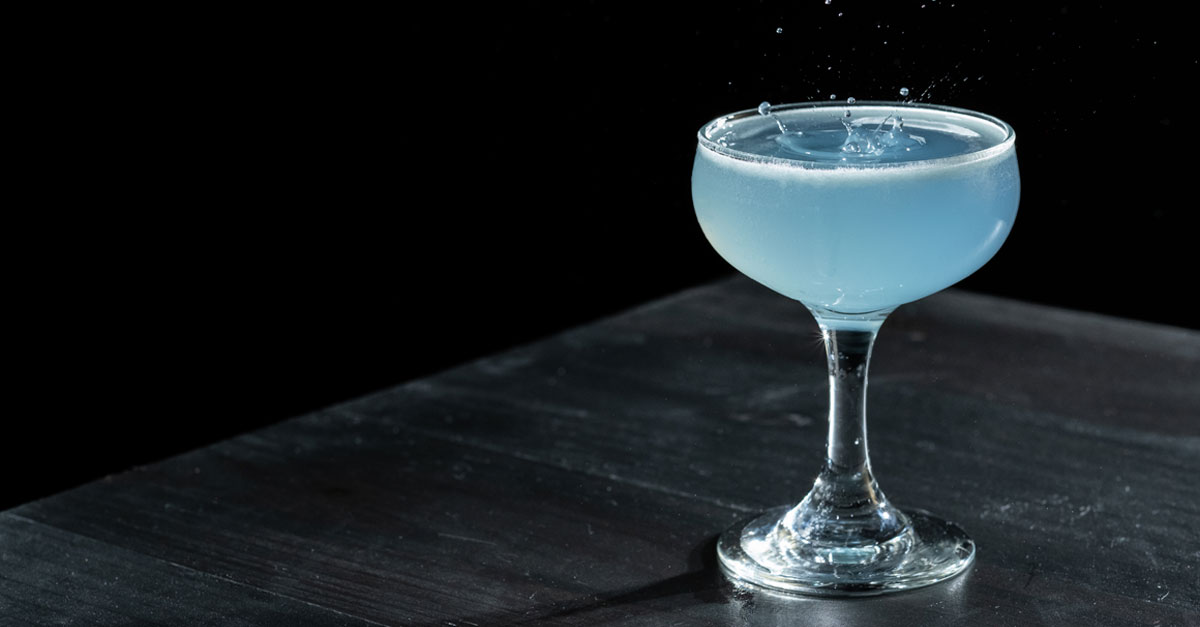Once referred to as a “forgotten classic,” the Aviation became one of the most popular gin cocktails in bars across America for a time. The earliest written mention of the drink was in Hugo Ensslin’s book published in 1916, titled "Recipes for Mixed Drinks." The recipe called for gin, lemon juice, Maraschino and a then-obscure French liqueur, crème de violette. Some believe the drink may have been lost to cocktail history if it had not been later included in "The Savoy Cocktail Book" by Harry Craddock, which listed an alternative recipe that omitted the hard-to-find violette liqueur.
Soon after the turn of the 21st century, the Aviation started making a comeback as bartenders began reviving Prohibition-era drinks. “It seemed like one of the first shaken gin cocktails that guests and bartenders alike were familiar with,” says Ms. Franky Marshall, a highly influential bartender and educator based in NYC. “It was always a crowd-pleaser, even for people who weren't sure if they actually liked gin.”
Marshall says that as the Aviation’s popularity grew, so too did demand for crème de violette, which prompted Eric Seed of Haus Alpenz to start importing a crème de violette into the U.S. — so bartenders could make a “proper" Aviation.
The Aviation is a delicate balance of tart and floral flavors, but due to its attractive sky blue or blush purple hue for which it is known, it’s often tempting to be too heavy-handed with the crème de violette. “When made properly, it's easy, approachable, and has that ‘not-too-sweet’ profile that people always ask for,” says Marshall. “When made poorly however, it can be overly tart and pucker-inducing. And as much as I love anything with a deep purple hue, this drink should not be one of them.”
For this drink, ms. franky marshall recommends using a more “modern” style gin, vs. a juniper-forward London dry style. She also notes a variance in the amount of Maraschino liqueur used, because the level of sweetness often varies brand to brand. As a cocktail this delicious, it may come as no surprise that the Aviation ranks among the 50 most popular cocktails in the world. To see the other 49, dive into the full list.
Best Practices: When Making an Aviation, Play With Proportions
The Aviation is included among the cocktails on the International Bartenders Association’s list of “Unforgettables” — 33 classic recipes well-versed barkeeps should be able to pull from their back pockets. In truth, at no point during its 100-odd-year history has the >Aviation flown so high as other drinks on that list, or approached the altitude of the Manhattan or Martini. But that’s not to say this cocktail is somehow bland or unremarkable like a long haul flight. In fact, the Aviation is quite the opposite.
Invented in 1916 by Hugo Ensslin, a German bartender working in New York, the Aviation combines gin, lemon juice, Maraschino liqueur, and crème de violette. Of those, the final ingredient — which gives this cocktail its signature sky-blue hue — proves most polarizing. Add with too much gusto, and the violet-infused liqueur can transform the drink into a potpourri of floral candy and soapy lavender notes. Add too little, and it misses the point.
For many years during the 20th century, bartenders even omitted crème de violette from their Aviation builds, in part because famed 1920s-era bartender Harry Craddock (intentionally or otherwise) did not include it in his version of the recipe in his renowned “Savoy Cocktail Book.” Even if they’d cared to include it, the ingredient was unavailable to American bartenders for most of the second half of the century.
Crème de violette was finally returned when Eric Seed, founder of the influential spirits importer Haus Alpenz, reintroduced the intensely colored liqueur to American palates in 2007.
The Aviation enjoyed a brief moment in the limelight. It was a notable component of America’s cocktail renaissance. But nowadays, discerning palates disagree over whether the Aviation should actually be ranked among the good or the bad of the cocktails resuscitated by that movement. (All, at least, would agree that this drink most certainly is not ugly, thanks to the vivid hue imparted by crème de violette.)
Love it or hate it, the Aviation is one drink that all cocktail enthusiasts should know how to make. Perfecting the drink provides worthy lessons in balance, the subjectivity of flavors, and the downside of following recipes with religious obedience.
Ready for liftoff? Here are five timeless tips for perfecting the Aviation cocktail.
What to Do When Making the Aviation
Build the cocktail around crème de violette (and your tolerance for the ingredient).
While gin is the main constituent of the Aviation, crème de violette defines the drink. Given the liqueur’s strong, sometimes polarizing flavor, it’s often included by the bar-spoonful, rather than in fractions of ounces. But before you even pick up the shaker, some bartenders recommend first analyzing the version of the liqueur you have on hand, as different brands have varying flavor profiles.
“Build the cocktail around the violette you're using,” says Brock Schulte, beverage director of Kansas City’s acclaimed cocktail bar The Monarch. Some examples, like Rothman & Winter, are bold and floral with a strong backbone, Schulte says. Others, such as Tempus Fugit’s Liqueur de Violettes, are lighter in style. By first tasting the liqueur, you can determine how much you want to include in your Aviation, and how much acidity (lemon juice) and sweetness (Maraschino liqueur) you will then want to add for balance.
For those looking to go full throttle with the crème de violette — up to ½ or ¾ ounce — introducing simple syrup also helps. “I've found that even Rothman & Winter crème de violette is not as complex as I want it to be,” says Boston-based bar consultant Ezra Star. “So I tend to up the quantity of the violette and add a bar spoon of simple syrup just to round it out really well.”
For those on the opposite end of the spectrum, Las Vegas-based beverage hospitality consultant Francesco Lafranconi recommends adding micro doses using an atomizer. “Add a couple of mists over your glass, strain in the shaken drink [minus the crème de violette], and spray two more mists before you serve,” he says.
While it requires some extra gadgetry, this (non-traditional) technique adds the bright, floral aromas with no risk of the liqueur hijacking the palate.
Decide on a style of gin, and adjust the recipe accordingly.
At this point, preparing a well-balanced Aviation may seem a bit like spinning plates, but there’s still one more considerable variable to add to the equation.
“The gin choice makes a big difference,” says David Yee, assistant manager at Columbus, Ohio’s Oddfellows Liquor Bar. From juniper-heavy London Dry to light and floral New Western, all styles are welcome in this drink, but the amount being added should be adjusted accordingly.
“If you're going London Dry, I would use 1 ½ ounces. But if you're using a more modern gin that has a lot of citrus peel, I would use 2 ounces,” says Yee. “You really want the gin to drive the drink.”
Serve in a Nick and Nora glass.
The Aviation is typically served inside a coupe or Martini glass, both of which provide visually striking presentation and shareability. When selecting glassware, though, there’s more to consider than how the drink looks.
According to Star, if the Aviation is instead poured into a chilled Nick and Nora glass, the glass’s slimmer profile helps promote the drink’s aromatic qualities.
“When you smell it [inside a Nick and Nora], it's more concentrated and you get more of the florals,” Star says. “With glasses that are a little wider, I don't think you can smell the violette as much.”
What to Avoid When Making the Aviation
Don’t be afraid to play with proportions.
Some cocktails, such as the Negroni, have recipes that are so well established they might as well be etched in stone. The Aviation is not one such drink.
Bartenders agree the four-ingredient recipe should be taken as a guideline rather than scripture. This is, admittedly, daunting for inexperienced home bartenders — and a tried and tested template is, of course, a great place to start. But don’t be afraid to tinker, bartenders say.
“At the end of the day, it should be about what you like,” says Lafranconi. “Some people like their Aviation sweeter, some like it more sour, others more aromatic — it's all about experimenting.”
Lafranconi is also not afraid to riff on the drink by including non-traditional ingredients. A bar spoon of St. Germain Elderflower liqueur can up the floral complexity, he says, while a splash of Prosecco creates a more approachable version — a sort of Aviation-French 75 hybrid.
Never “float” the crème de violette.
Those seeking the perfect Instagram snap may be tempted to “float” the crème de violette on top of the cocktail rather than including it in the shaker with the other ingredients. The separation of the different colored solutions is, admittedly, visually stunning. But if you plan on drinking your cocktail, sink this idea.
“Never float the violette. That's like, the worst way to serve this drink,” says Yee. He adds that crème de violette “is not a liqueur you want to serve warm.”
After all, you’ll want your Aviation to do more than float; you’ll want it to soar.

